#travel hacking
Badass trips on a not-so-badass budget.
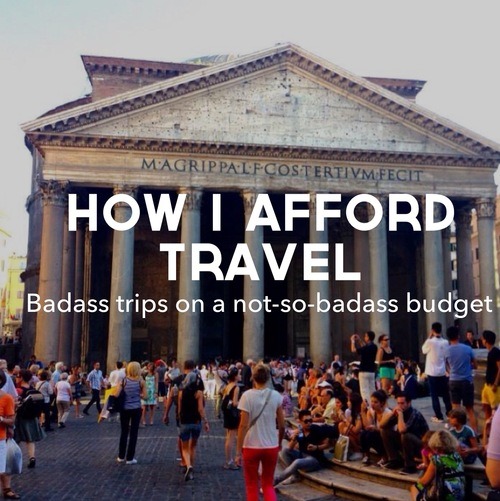
Many travel blogs are written by people who’ve sold all their possessions and have taken a huge plunge into the world of long-term travel. This can sound expensive at first, but when you consider that you don’t have rent or a car payment in this lifestyle (or much room to carry any possessions), it can actually be very cheap to live this way, provided you can work a little along the way, or do some kind of virtual freelancing or contract work.
I’m not one of those people.
I do have rent to pay, and a car payment, and bills, and the trappings of a fairly typical middle class young urban professional life. I have a cat. I work in a cubicle. I like some amount of routine, and sleeping in my own bed. I have a ladder to climb, that I want to climb.
I also don’t have a ton of free income to spend on travel.
Despite all this, in the past 2 years I’ve managed to visit 9 cities in 4 countries (Colombia, Jordan, Egypt, Spain) and very soon I’ll be off to visit 7 more cities in 3 countries (Italy, Croatia, and Spain again – I love Spain), a 17 day trip; a few weeks after I return, I’m off again on a small trip to Mexico for a wedding. When I’m done, that’s 16 cities, 7 countries, in just 2 years. Not much for the permanent nomad, but a lot for someone who’s expected to be at work by 8:30am every weekday.
When people find out how much I travel, some imagine I must have a lot of spare income or be a trust fund baby. I keep encountering this perception – especially among Americans – that travel is this huge undertaking that is incredibly expensive. Well, it sure can be, if you choose to make it that way. But if you step outside this perception, and do some research, you’ll find that it really doesn’t have to be that way. Travel can be affordable, if you plan for it and prioritize it in your life.
Here’s how I do it:
1. Flights. By far, this can be the single most expensive purchase of your trip. A coach round trip ticket from the US to Europe usually runs anywhere from $700-1200 on average, depending on the season. The trick is: don’t buy your ticket with actual money. Buy it with fake money called points or miles. A few years ago, I strategically opened 2 different credit cards (one an AmEx, one a British Airways Visa) with unusually crazy high enrollment bonuses. Within just a few months’ time I went from 0 miles to 50,000 AmEx points (redeemable for airline miles on at least a 1:1 basis) and 100,000 British Airways miles. Keep in mind, BA is part of the OneWorld alliance, so I can book with other airlines using these miles. In just a few months’ time, with 2 credit cards (that didn’t hurt my credit, by the way) I earned enough miles to take 3 international round trip flights – without ever stepping on an airplane. I got the AmEx points simply for opening the card, and I earned the BA miles after spending $2500 in 3 months, which wasn’t that hard for me because I strategically put ALL my expenses on the card for 3 months.
The trick is knowing which cards to open. These cards usually aren’t well advertised, so you’ll have to do your research. A few good resources to get you started:
Upgrade Unlocked by Chris Guillebeau. This is actually the first resource I used to learn more about travel hacking. If you’re a total newb, as I was, this is the best introduction to the world of frequent flyer miles that exists. But it’s not overly simplistic; there are a ton of insider tricks and tools in here that I haven’t even taken advantage of yet. This guide is the reason I earned 150,000 miles without stepping foot on an airplane.
FrugalTravelGuy.com This is a great blog for those interested in staying up to date on the latest frequent flyer news and credit card offers.
FlyerTalk.com This is a forum for the serious hardcore travel hackers – the credit card “churners” who sometimes earn up to 1 million miles a year doing this. FlyerTalk can be intimidating at first if you’re new to all this, so I’d recommend starting from the top and working your way down.
2. Rooms. Very rarely do I stay in what most Americans think of as a “hotel” when I travel abroad. Many travel hackers and frequent business travelers are loyal to a certain brand of hotel, especially those with their own reward points systems, which earn them free stays (and yes, there are credit cards for this too). These can be a great value and I do participate in a few programs like Hilton HHonors for stateside bookings. For my international trips, however, I prefer everyday price flexibility, so I book a variety of inexpensive, off the beaten path accommodation types – and none of them involve splitting a room with strangers, camping (not counting the bedouin camp I stayed with in Petra, which I did for the experience and not the savings), or couchsurfing. A lot of people associate budget travel with roughing it, but it is possible to be comfortable. In fact, by avoiding the beaten path, I usually have a less expensive, equally as comfortable, and more interesting cultural experience.
Most of my international trips have involved staying at a combination of private rooms at hostels, small independently owned hotels, bed & breakfasts, and private apartments.
Hostelworld.com This room search and booking site will expand your idea of what a hostel can be. Often you’ll find that smaller, inexpensive and independent hotels will list rooms on Hostelworld even if they have a website and brand themselves as a hotel or bed & breakfast. You can search for rooms nearly anywhere in the world, filter by room type (most hostels have private bedrooms, some with private bathrooms and some with shared bathrooms), location (there’s a handy map view), price and more. It’s also low risk - you just pay a small 10% down payment when you book and the rest when you check in. I’ve stayed in some very nice hostels for a fraction of the cost of an equal quality hotel and it’s one of the first places I look when I start planning a trip.
Booking.com This is a rising star in the online travel booking world for hotels. Based in Amsterdam, they are one of my top sources for rooms in Europe (though they offer rooms in several other parts of the world too). Booking.com’s strength is their breadth of rooms available; you can find a variety of low-cost, tiny, independently owned hotels that will be difficult or impossible to find elsewhere. They even offer free cancellation on many rooms. Their pricing also cannot be beat – sometimes I even find rooms that are less expensive than hostels!
Airbnb.com I am a huge fan of this service. A major disruptor to the online travel booking industry, Airbnb offers you the ability to reserve a room in a private apartment directly through someone who lives and is local to the place you’re going. You can book entire apartments or just spare bedrooms, allowing you the choice between having a cozy place all to yourself or staying with – and getting to know– a local, something that may not have happened otherwise (and my most memorable trips have been those in which I connected with locals while I was there). A few other perks can involve more amenities than a budget hostel or hotel may offer, such as the ability to wash your own laundry or cook your own food if you need to (it is an apartment, after all). I travel for 2 weeks at a time when possible (more on that later), and I pack only a carry-on. After a week like that, a washing machine is an unexpectedly welcome blessing. You’ll also get to feel more like a local, even if you never meet your host. You’re staying in a neighborhood, not a commercial, touristy zone. There’s a lot to be said for that. Finally, I love their website. Not only very easy to use and socially integrated, the design is beautiful. I love flipping through the home slideshow of gorgeous apartments on offer. It’s interior design porn at its most authentic – these are real peoples’ homes!
3. Timing and trip length. I would be remiss to say that the above 2 factors are the only methods I use to travel to so many places affordably. The fact is, I can say I fit in 16 cities and 7 countries in 2 years because of how many of those cities and countries I manage to pack into a single trip. In 2011, I did only a 1-week trip to Colombia. In 2012, I did a 17-day trip to Jordan, Egypt, and Spain. This year, I’ll do another 17-day trip (that’s essentially 12 vacation days) to Italy, Croatia, and Spain. Considering all the places within those countries I travel to in each trip, I typically pack up and move on every 2-3 days. That’s not a lot of time in each place! Just enough to visit the major sites, take in the atmosphere, and decide if I’m intrigued enough to return someday to make a longer trip of it.
This pace is not for everyone, but it works for me. I’m restless, and like squeezing every drop out of my precious vacation days. Plus, nothing’s worse than booking 5 days in a place you’ve never been, only to arrive and find out you’re bored after 1 day and it’s too late to make any changes. I intend to see the world, and I have to do it in 2 weeks per year. So, I compromise. It can be a little tiring, but I don’t take these trips necessarily to relax – I take them to recharge in other ways. Travel is my passion and I crave new cultural experiences. My worldview has expanded a little more each time I set foot on US soil again; this is creative fuel to the fire of everything I do, from painting to marketing strategy. That’s why I’m determined to prioritize it, even with a limited budget. For those who’ve also been bitten by the travel bug, you get it. The rest of the world will go on thinking that we’re rich, and I suppose that’s fine.
–
UPDATE: Wow, this is officially my most popular blog post ever! Thank you all for reading and sharing with your friends. I received a ton of follow-up questions about specific credit cards and mileage reward programs, and I did my best to answer them in a new article, “How I Fly Around the World for Next to Nothing.” Check it out!
–
New here? Let me come to you!Subscribe by email to get more articles like these (plus some extra fun stuff) delivered straight to your inbox: http://travelpaintrepeat.com/subscribe

At the Hotel Oriental Rivoli in Sharm el Sheikh, Egypt. Somewhat fancy, resort-style digs. About $60/night.

I first came upon the term “travel hacking” in 2010. I was a fan of Chris Guillebeau’s blog and finally decided to buy one of his Unconventional Guides. It was actually not about travel - it was about making money as an artist. After flipping through it, I realized I wasn’t the right audience for it, as it was written for artists with less experience at actually making money from their work. So I wrote to Chris, gave him my feedback, and asked if I could return it. Before I hit send, I made a tiny decision that has changed my life forever. I asked if I could instead exchange it for Frequent Flyer Master. Chris agreed.
Because of what I learned in Frequent Flyer Master, I’ve been able to travel the world every year since, flying for free on strategically earned miles. I’ve visited Colombia, Spain, Jordan, Egypt, Italy, Croatia, Brazil, and Mexico, going away for 2 weeks at a time, averaging about $2,000 spent total per trip. All this despite my full time job, student loans, and middle class income.
So I wanted to tell you about a new travel hacking guide that Chris Guillebeau released just this week.
It’s called Upgrade Unlocked and it covers all aspects of travel hacking, not just the flights (on which Frequent Flyer Master goes into more detail). It also focuses on how to get that elusive upgrade, so that travel hacking doesn’t have to mean travel bumming-it. Best of all, it’s super cheap - just $39 for the basic version, with 2 levels of “upgraded” versions that are just $58 and $97 right now (introductory sale price).
If you dream of traveling but think you can’t because you’re not made of money, I highly recommend you check out Upgrade Unlocked. Click here to learn more and get a free preview of the guide.
Check out some of my past articles on my own travel hacking experiences:
How I Afford Travel: Badass Trips on a Not-So-Badass Budget
How I Fly Around The World For Next To Nothing
—
New here? Let me come to you! Subscribe by email to get more articles like these (plus some extra fun stuff) delivered straight to your inbox: http://travelpaintrepeat.com/subscribe

Give this to your parents, friends, significant others, coworkers, random people, or anyone else who tries to warn you about the dangers of travel. I’ve been to post-revolutionary Cairo in 2012, Colombia, most of the pickpocketing capitals of the world, and a variety of other places where I felt more safe than I have in many neighborhoods in America.
How to Stay Safe While Traveling
It’s worth noting that many parts of the world — including a lot of popular tourist destinations — are less dangerous than the United States. Some people have a perception that the life they know in America is quite safe, but the rate of violent crime in the U.S. is high for a developed country. In any given situation in life — getting in your car to drive to school or work every day or just crossing the street — there is a certain risk involved. Before you consider the danger of visiting a foreign country, do not discount the danger you face and mitigate successfully everyday. I like to frame it like this: Imagine you’re a parent or teacher, and think about the advice you might give a born-and-raised, sheltered suburban kid about staying safe on a trip to New York City. This is, in essence, good and solid advice for any person about to travel to most major tourist destinations around the world.
Click here to read the full article on eHow: http://bit.ly/ehowmvg18
Advice for the young, ballsy, and indecisive.

I’ve received a lot of questions from readers lately about careers and jobs, mostly from those in high school, college, or recent graduates. The questions take many forms and specific topics, but the underlying panic is:
“What the hell should I do for a career?!”
Some people seem to know innately what they were born to do, and forge ahead accordingly. Meanwhile, others struggle with the big life decision of settling on a career path. I’ve been on both sides of this coin. I’m only in my late twenties and still figuring things out myself, so I don’t suggest that I have all the answers - but I have learned a few things along the way.
Here are my words of advice, along with a few tools and resources that might help if you’re feeling stuck, indecisive, or anxious about the pressure to Choose Your Perfect Career.
First of all, though, let’s agree on one thing:
The concept of a “perfect career” as we commonly think of it is bullshit. It contains the romantic, narrow, and dangerously incorrect notion that there’s only type of job, profession, or career that you will ever be happy in.
Throw away the fairy tale.
There are no such thing as soul mates, and there is no such thing as your one true perfect career. You can be happy doing a variety of things for love and money.(click to tweet)
I held onto this belief for way too long. From a very young age I believed with full conviction that the life of a gallery-represented painter was the only career that would make me happy, and my ability to achieve this was the only measure by which I could consider myself successful (I know, heavyright?). I drowned my creativity under waves of pressure and perfectionism, trying to live up to my own lofty expectations in an intensely competitive and completely nonsensical market. Thankfully, I was able to dig myself out of this, with my love of painting fragile but intact, and my sense of self sharpened.
Chances are you’ve been trained to think very singularly about “what you want to do for the rest of your life.” You’ve been (or will be) asked to choose a major in college, maybe even put through lessons and too many extracurricular activities and given aptitude tests. And yes, to get through a college education you will need to choose a major and place your bets on a particular course of action. But the truth is, you are a dynamic, multifaceted being with so many potential directions. You will do many things in life, go down many roads you can’t even foresee right now. And what specific topic you choose to study in college really, honestly, will not matter in the long run, in most cases.
What does matter is what you choose to do with your unique matrix of interests, useful skills, and knowledge. I believe firmly in the concept of designing your own career path. Not everyone has the same path towards the same job (I’m a former painting major now working in social strategy at an advertising agency, for example), and the landscape changes every day. When I was in school, and for even a few years after, the job I have now didn’t even exist.
An entrepreneurial attitude to your career and life is no longer optional. There is no longer a blueprint to follow. You’ve got to make your own way.
(Click to tweet)
“Great! Except… I have no idea where to start.”
If you weren’t blessed with a strong passion or career direction early on in life, please know that you are in fact, quite normal. You probably even hold the advantage - you’re open to many things early on (remember how my initial passion turned out to be quite narrow?). At this stage, it’s a good idea to do some research - about yourself. You are always changing and growing, so no matter where you are in your career, it’s always helpful to check in and get to know you a little better. In my experience, there’s no better way to do this than to put pen to paper.
1. If you want to know yourself, start writing.
Guided writing exercises and workbooks were most helpful to me when I broke free of the idea that there was One True Thing I was supposed to do in life. At that point, 3 years out of college, the girl who always knew what she wanted to do with her life found herself squarely on her ass, unemployed in a new city, wondering anxiously what was next.
Books can help you, and even give you a somewhat false sense of productivity, but nothing helped more than digging up my own words and arranging them on paper in a way that made sense. It’s totally a metaphor for what’s going on inside you - a jumble of confusion, the right parts are there somewhere but out of order. In a very real way, writing helps put the puzzle pieces together.
I spent a lot of time reading and poring through books, digital downloads, and countless articles online, but nothing helped guide me through this messy, transformative process like The Desire Map by Danielle Laporte.
Because of the writing exercises and guidebooks I found in The Desire Map, I came out on the other side a little clearer, and with a firmer understanding that how I want to feel every day should be at the core of these important life decisions. Once you know this, you have your very own proverbial North Star to guide you in countless ways.
(Full disclosure: if you click the link above and decide you want to try The Desire Map too, I’ll receive a small percentage of the sale - but please know I would never endorse something I didn’t use and love myself. In fact, I purchased The Desire Map years ago and still refer to the scribbled notes I took in it frequently.)
And if you already have a passion, and are sure you know what you want to do, great!
As you get older and more experienced, be open to letting that unfold and evolve. I clung desperately to this narrow idea of what I was supposed to do with my life mostly out of fear. Everyone my whole life expected me to become a successful artist, and I’d seen so many people give up along the way – the last thing I wanted was to be seen as giving up too. But after a while, I realized I’ll always be an artist so long as I keep painting, external recognition be damned - and anyone who thinks otherwise can jump in a lake. Plenty of successful artists hold down day jobs, and many even keep them when they don’t need the money because they like them and find them fulfilling. It doesn’t have to be so black and white.
Which leads me to my second piece of advice…
2. If you want to understand how others have done it, stalk people on LinkedIn.
When I was “squarely on my ass” and unemployed with no direction, the reason I figured out what kind of careers might be a good fit for me is I incessantly stalked people on LinkedIn.
Get on LinkedIn if you’re not, and search for people who started from similar places. It’s not hard to reverse-engineer their career paths. How did they move from one job to another? The more digital-savvy of them will have very complete profiles that easily allow you to examine how they got from A to B, or what traits or job responsibilities helped them pivot from one industry or role to another if something wasn’t working for them.
LinkedIn recently even launched a tool called Field of Study Explorer to make your stalking/reverse-engineering even easier. Check it out in their new blog post (well worth a read all on its own), “Does Studying Fine Art = Unemployment? Introducing LinkedIn’s Field of Study Explorer.”
A writer for Mashable also tested this idea, working with LinkedIn’s data science team to find his “future self” among other LinkedIn users with a similar background: “How LinkedIn Found My ‘Future’ Self.”
In my case, there were several people who unknowingly helped me understand what my possibilities were, but one in particular later became my friend. One day while searching for profiles and jobs on LinkedIn, I saw that a fun-looking woman around my age named Elysa had attended my university for a graphic design degree and worked her way from designer to well-known leader in the field of digital strategy (and a successful blogger to boot!). She was kind enough to meet me for coffee on her way to a speaking engagement at SXSW. I learned so much from that one conversation – as a jobless 25 year old, I understood at that point that the only thing separating me from progress was myself.
The only thing was, I still needed to figure out how to make money from what I’d discovered with The Desire Map.
Remember that unique matrix of useful skills, interests, and knowledge I mentioned earlier?
3. Well, here it is:
Click here to use this Google Sheet for yourself: http://bit.ly/gridtoolmv
It’s critical to remember that if you want to make money at something, it has to be useful to others. This very basic principle applies whether you’re someone’s assistant (no shame here, I’ve done it!) in which you are selling your organizational services in exchange for benefits and a salary, or you’re a gallery painter selling the product of artwork that brings real joy to its new owners.
To understand these transactions as anything else (I’m just an employee! I’m not selling anythingor,I’m not selling a product - how dare you, I’m an artist!) is to not fully understand business or the real world, or as Ramit Sethi calls it, the game being played around you. And the sooner you get on board with this concept, the better equipped you’ll be to find a career that both makes you happy and makes you money.
My very sincere advice would be to think long and hard about what you enjoy doing (even just hobbies - doesn’t have to be “job-like”) and what you’re naturally skilled at (things like “being a good listener” and “talking to people about their problems” totally count here, by the way) and compare that to what you think might actually be useful to random people you don’t know. Put more simply,
What are you good at or enjoy doing that solves other people’s problems?
Start there. With some soul searching, writing, and very realistic analysis, you’ll find yourself starting down a path to a long, lucrative career path that is uniquely yours, fun, exciting and never static.
—
New here? Let me come to you! Subscribe by email to get more articles like these (plus some extra fun stuff) delivered straight to your inbox: http://travelpaintrepeat.com/subscribe
You can also follow meonPinterest,Instagram, Twitter&Facebook.
I understand that some people may be intimidated by the world of travel hacking and frequent flyer miles, or just not interested in putting in the time or effort that it can sometimes require (though the rewards can be incredible!) - but that doesn’t mean they want to overpay for flights and vacations. Even I occasionally choose to pay cash for flights - like on my upcoming trip to Brazil, because I wasn’t comfortable waiting to find out if any airlines would open up reward seats on high-demand flights to the World Cup. It pays to know which sites are going to help you find the best deal - and I’ve outlined a few of my favorite in my latest article for eHow:
Save Money on Travel with These 4 Websites
Money-savvy travelers have never had a wider variety of digital tools at their disposal for finding low fares and prices. As a seasoned traveler, I’ve found the following websites and digital tools most useful for saving money on amazing trips. Add these to your budget travel toolkit by bookmarking them now.
Click here to read the full article on eHow Money! http://bit.ly/ehowmvg3
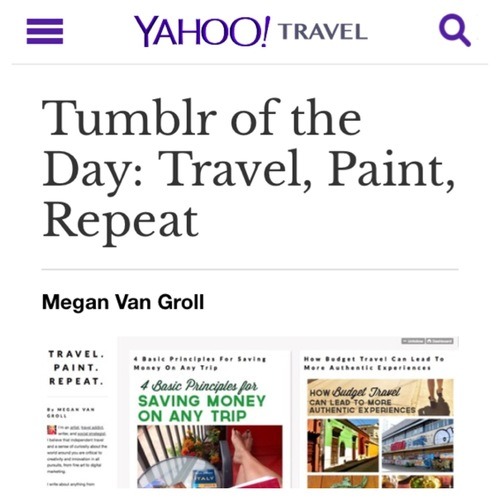
It’s been a pretty cool week for me as a blogger! In addition to my article, How Budget Travel Can Lead to More Authentic Experiences being featured on the front page of eHow, Yahoo Travel has selected Travel Paint Repeat as its Tumblr of the Day!
Here’s what they had to say:
Visit Travel Paint Repeat for insights into how travel can change us, and to peruse the gorgeous photos; stay for the money-saving tips and travel hacks.
Click here to see the full feature.
ThanksYahoo Travel for sharing my travel writing and photography with others.
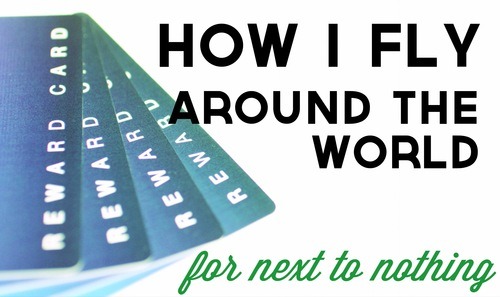
Since I posted my recent article How I Afford Travel: Badass Trips On A Not-So-Badass Budget, I’ve received a lot of questions asking me to go into more specifics. I started learning how to do this a few years ago, and since then I’ve successfully taken several international flights that were paid for almost entirely by frequent flyer miles – miles I earned without stepping foot on an airplane. My friends, this little-known, totally legal game is called travel hacking. And I’m happy to share specifics with you – I’ll even share details of my most recent trip, explaining exactly how I did it and how much I paid for my flights.
But before we dive into this, we should identify your travel goals.
Ask yourself: Do you already know where you want to go? Or can you be flexible?
See, there are ultimately 2 ways to approach earning and redeeming miles for free flights.
Strategy 1: Decide where you want to go, and plan accordingly.
Certain airlines are better for certain destinations, and the valuation of miles can vary widely from airline to airline. If you know where you want to go, you can review award charts, award maps, and redemption rates to figure out which airline will give you the best deal. Most airlines are part of an alliance, meaning you can redeem one airline’s miles for flights on another – for example, you can redeem British Airways miles for American Airlines flights because they’re both part of the OneWorld Alliance. Once you know which airline – or which airline alliance – will get you to your preferred destination for the lowest number of miles, you can keep an eye out for valuable cards from those frequent flyer programs (I’ll explain how to find these cards in a few).
Strategy 2: If you’re open-minded, find the best offers and figure out where to go later.
This method is all about choosing the credit card offer that gives you the best sign-up bonus and points per dollar spent, and is part of an alliance that gives you plenty of options – then stockpiling the miles for your future mystery trip. When it’s time to plan your trip, have several options in mind and choose the one that costs the least amount of points. Disclaimer: This doesn’t work if later on you don't want to be flexible (I’ll tell you how this happened to me in a bit).
But, keep in mind there are more ways to earn miles than credit cards.
Everyday online shopping. Many airlines have online shopping malls that allow you to earn miles per dollar spent. You simply login to your account, find the store you want to purchase online from, and click through to that store’s website. Tracking cookies will do the rest. With everything from Walmart, Sears, Kohl’s, and Sephora to higher-end department stores, there are tons of ways to funnel everyday online purchases through an airline’s shopping mall to passively earn tons of miles without ever getting on an airplane. It’s so easy it’s stupid.
EVReward.com. This site is basically Google for shopping rewards. Just type in which store you want to shop and it’ll tell you which reward programs you can use to earn points or miles there.
Travel hacking comes with huge benefits – and I’m not just talking about free flights.
Free stopovers means you can see more places.
When you book reward flights, you can strategically add a stopover for free – and then stay at that stopover location for several days, thereby adding another destination to your trip. When I went to Jordan, Egypt, and Spain, my original flight was from JFK to Sharm El Sheikh (where I went scuba diving in the Red Sea) with a stopover in Amman, which I used as a base when exploring Petra, Jerash, and the Dead Sea. But my return flight was from Cairo to JFK, with a stopover in Madrid. All I had to do was get from Sharm El Sheikh to Cairo, which was a very cheap in-country flight I purchased separately.
You can do this with many airlines. They value your flight from point A (in this case, Cairo) to point B (JFK), and if there is a combination of flights that routes you with a stopover in an amazing location, so be it. It’s your job to research those flights on the airline’s website to find the ones you really want – your stopover will probably have to be in a hub city. Notice also that my roundtrip reward flight included flying to and returning from different cities – I didn’t have to make it back to Sharm to fly home. That flexibility, called Open Jaw, is another benefit of reward flights.
You’re more likely to see places you otherwise might never have.
All of this means you’re opening yourself up to more options than you’d have with a paid flight. If it’s just as easy to fly home from a different city than the one you arrived in, and if it’s cheap to get from that city to the other, why wouldn’t you? And if you’re going with Strategy 2, valuing flexibility over any one destination, when it comes time to book a trip, you wind up researching a variety of amazing trips to see which one makes the most sense – which can lead to some off-the-beaten path places. I’m admittedly something of a Europhile and I’d been dying to go back to Italy since I studied abroad there 7 years ago. Do you think I was itching to get to the Middle East first? No, but the opportunity to visit a part of the world I may never get the chance to again (considering the tumultuous political climate) was too good to pass up. I let flexibility and opportunity take the reigns, and had an amazing experience I’ll never forget.
And you know what? I still made it to Italy on miles the next year. In fact, I’ll use that trip to give you another example of how you can use miles to book flights in creative ways - and I’ll even tell you exactly how much I paid for each flight.
Itinerary: Germany, Italy, Croatia, and Spain
(Yep, Spain again. Did I mention I’m also a bit of Spanophile?)
Here’s how it worked:
Flight 1: DFW to ORD (Chicago) - Spirit Airlines - $118.89.
The best mileage deal that got us to Europe was from ORD to Berlin. I could have also used British Airways miles to get from DFW to Chicago, but it seemed more prudent to save those and shell out for a cheap flight to ORD. It was still significantly cheaper than if we’d purchased the RT US-to-Europe ticket outright. Most international flights leave in the evening, so we had all day to get to ORD. Easy.
Flight 2: ORD (Chicago) to Berlin - AirBerlin 25,000 miles and a $2.50 mileage surcharge fee.
Mileage surcharges are fees that airlines charge in addition to the miles you’re redeeming. They can vary depending on how many miles you want to use, and the airline’s policies. However, sometimes airlines charge much more – like British Airways, in this case.
We weren’t initially planning to go to Germany on this trip. We were concerned primarily with going to Italy and Croatia (in this case we were being a little less flexible – we were dead set on going to Italy and Croatia but the flights weren’t working out perfectly). However, British Airways charged $300+ in mileage surcharges to get us to Europe on BA and most of their OneWorld partners, but for some reason only $2.50 on AirBerlin – but the catch was we had to fly into Berlin. Inter-European flights are so cheap that it was financially more viable to fly into Berlin, then immediately fly to Florence on another ticket. In this case we decided to stay one night in Berlin, but we could have had just a short layover at the airport before heading to Florence if we preferred.
Flight 3: Berlin to Florence. Vueling, paid 92.42 Euros (approx. US $125).
Vueling had the cheapest airfare from Berlin to Florence. Note that we researched the cost of both this and the Spirit flight that got us to Chicago before ever booking our reward flights, to make sure it all still worked out financially in our favor.
Flight 4: Rome to Dubrovnik - Croatia Airlines, paid 1,581 Croatian Kuna (approx US $282).
We agonized over how to get from Italy to Croatia. Despite being just a short crossing of the Adriatic, the flights were quite expensive. Though we could have taken a bus or an overnight ferry, we made a decision to value our time over our money, biting the bullet and taking the Rome-Dubrovnik flight.
It cost almost $300 per person – not ideal. But the story behind this flight is somewhat interesting: though we only needed a one-way, the flight we booked was actually a round trip. Several months later, a flight left from Zagreb for London with our names on the roster, but our butts back home in Dallas. It’s ridiculous that it was cheaper to book a round trip flight that included destinations we had no intention of visiting than it was to simply book a one-way, but that’s the weird, irrational nature of airline pricing.
Flight 5: Dubrovnik to Barcelona - Vueling, paid 98.24 Euros (approx. US $134).
We found good options out of Barcelona, so we decided to tack that onto our trip. Barcelona is one of my favorite cities in the world, so of course I jumped at the chance to spend a few days there at the end of our trip. We paid $134 each for this Vueling flight.
Flight 6: BCN (Barcelona) to DFW - 30,000 miles and a $49.98 mileage surcharge fee.
We actually could have flown out of either Barcelona or Paris for the same amount of miles + fees, but we opted for Barcelona. Fortunately, our itinerary got us back to DFW, through Miami, without having to fork a few more dollars over to Spirit.
So, in the end, this was actually sort of an expensive trip for a travel hacker, just considering flights alone (although we did take 6 of them!). Keep in mind, the flights to and from Europe were only $171.37 (that’s including the paid Spirit flight to get to ORD)! We then spent $541 on inter-European flights (paid with cash, not miles), which was unusually high for us. This is because we went with Strategy 2 – originally accruing miles not knowing everywhere we’d want to go, and then being pretty specific about destinations after the fact. If we’d been less picky about going to Croatia, or willing to travel more slowly within Europe, we could have spent a lot less money.
Hopefully this helps illustrate how you can creatively use reward flights to travel in ways that are not only more cost effective but also more interesting.
If you want more information on how to do this yourself, you’ll need some good resources to get you started.
As I mentioned in How I Afford Travel, I learned the basics in 2010 from Upgrade Unlocked by Chris Guillebeau. Hundreds of thousands of miles earned and several international trips later, I still think it’s the best, most comprehensive, yet least intimidating guide for those who are totally new to this. My best advice to anyone looking to get started as a travel hacker is to pick up Upgrade Unlocked, print that sucker out and dive in.
You can also check out the blogs of well-known travel hackers, including ThePointsGuy.com,FrugalTravelGuy.com, and forums like FlyerTalk.com to get more information.
How to find the best reward credit cards:
Several people have asked if the Upgrade Unlocked covers specific credit cards. Yes, in addition to teaching you about all the different tactics, tricks, and strategies for earning and redeeming miles, it will tell you about the best overall credit cards for travelers. But the more rare bonus offers – like the one that earned me 100,000 British Airways miles – will come and go more quickly. They’re not always advertised by credit card companies, and the best deals only last for a few hours. So how do you find out about them?
There are two options:
1. Know where to look and do the research. There are a couple of mileage bloggers who write about credit card offers, including FrugalTravelGuy.com. The most up-to-date information is on Flyertalk.com, which is where all the pro travel hackers hang out and trade secrets.
2. Take the lazy/busy person’s route. It’s a lot of work to keep up with this stuff. If you’re not up for it, you can instead be alerted to new reward deals as they happen with a notification service like Travel Hacking Cartel. This was started by the same travel hacker who created Upgrade Unlocked. His team of travel hacking experts research new deals (including mistake fares) constantly, alerting you in real time. It’s a paid service — it’ll run you $15 per month — but he guarantees you’ll earn 4 free plane tickets per year.
Not from the United States? As you might have figured out, most of the info out there is for Americans, so you’re probably having a hard time finding information on reward programs for everyone else. Well, about half of the Deal Alerts in the Travel Hacking Cartel are for non-US citizens. I personally don’t know of any other service that alerts you to non-US deals, so if you’re from elsewhere in this great big world and serious about travel hacking, this might be worth checking out.
So there you have it. This is my honest advice for anyone interested in playing the travel hacking and reward credit card game. This whole travel hacking thing can seem intimidating at first, but with a little research and willingness to learn, you can be on your way to the trip of a lifetime for next to nothing. Trust me – it is definitely worth it.
—
Let me come to you! Subscribe by email to get more articles like these delivered straight to your inbox: http://travelpaintrepeat.com/subscribe

Luxor, Egypt. 2012
Know someone who’s planning a trip? Maybe just dreaming about it and needs a little kick in the pants? With the holidays right around the corner, I thought I’d share some ideas for gifts that might be of interest to anyone from the wanderlusty travel slacker to the seasoned frequent flyer. From books that’ll inspire you to leave home to products I’ve used on my trips (and now don’t leave for the airport without), this is my personal list of the best loot for the travel-minded.
Best of all, most of these are under $20!In no particular order:
1. Gift Subscription to Afar Magazine. Hands down the best, most beautiful magazine I’ve seen for those who prefer independent, off the beaten path experiences when they travel. Published 7 times a year, this publication features very well curated recommendations, a behind-the-scenes look at destinations, and great advice on traveling like a local, all packaged within gorgeous, stunning photography and editorial design. $20 for 1 year (7 issues).
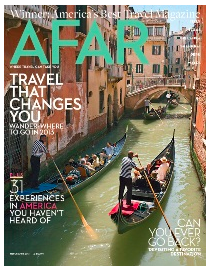
2. Travelon Bag Bungee. I’m a big fan of small rolling suitcases (and fitting 2 weeks’ worth of clothing inside). For long trips, it can get pretty tiring hauling a duffel or one of those huge monstrosities you see backpackers wear (though I’m sure they’re great, I never enjoy looking like a tourist when I’m in a foreign country, and guess what those instantly accomplish?). However, you’re bound to have more than just the suitcase. Any kind of extra bag - laptop bag, “personal item”, purse, sack, or even shopping bag is going to be difficult to manage at the same time as your jacket, boarding pass, passport, bottle of water, sanity, etc. So, what do you do? You bungee it! I can’t believe I did my big 17-day trip to the Middle East and Spain last year without this thing. It’s great. It will literally hold anything on top of your suitcase that won’t fall between the 2 bars of your handle. At one point in Croatia we were balancing a nerdy man-purse on this thing with open side pockets containing a 1-liter bottle of wine on one side and some red party cups in the other (that were inexplicably tiny - I have no idea how Croatians would play beer pong). So, yeah. I recommend it. $11.20 on Amazon.
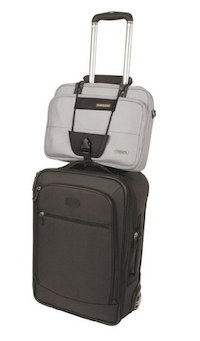
3. 1,000 Places to See Before You Die. This is a great book for someone who knows they want to travel but isn’t sure where they should go. This is also a great reference for someone who’s already well-traveled – there’s sure to be an idea in here to inspire their next trip. From $15.36 (paperback).

4. Inflatable Neck Pillow. Long flights, economy seats (well, that’s how I fly anyway - when you’re flying for free you’re pretty happy with coach!). Comfort level - not high. But have you ever seen someone with one of these neck pillows attached to the outside of their luggage, or (cringe) worse - around their necks as they walk through the airport. Yeah, don’t be that guy. Be the guy with the neck pillow that stays hidden and takes up zero space until you get on the plane. I give you, the inflatable neck pillow. (This particular brand has a huge valve – not your typical balloon valve – that allows you to inflate and deflate quickly, with minimal effort.) Available on Amazon for $12.30.

5. The New York Times, 36 Hours: 125 Weekends in Europe. This gorgeous hardcover book compiles the best of the New York Time's 36 Hours series, with this book focusing on Europe. I myself have taken amazing trips to locations that were otherwise not on my radar (like Cartagena, Colombia), inspired solely by these 36 Hour articles - check them out even if you don’t get this book. $34.04 (hardcover).
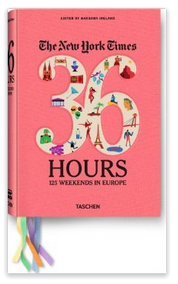
6.Luckies of London Scratch Map. Getting back from a trip and reconciling your amazing adventure with your regular life can be tough. You want to keep the memory alive while staying motivated to plan your next trip. Hang up this unique scratch map in your living room, scratch off the areas you’ve been, and await both the envy of your friends and the nagging voice of your inner travel addict urging you to scratch off more places… Available for $20.55.

7.Pilot & Capt. Civic Pride Shirts. Let’s face it, most souvenir t-shirts suck. They scream “I’m a tourist” even when you’re back on domestic soil. Alternatively, maybe you found a nice-looking one but hesitated to buy during your trip because you had limited luggage space. Instead, pick up one of these shirts when you get back (or to help celebrate someone else’s big trip!) to express your love for the city you left your heart in. (Available in a limited number of city versions for now, but let’s hope that changes.) $32.00 from pilotandcaptain.com.

8. Travel Power Strip. Imagine you (or your lucky traveling gift receiving friend!) has just returned from a tiring, exciting day of exploring a new city. They arrive back at their hostel or hotel and realize their camera or phone (or both!) is low on battery. Oh, and their travel partner’s phone is too! But there’s only one adapter. Or, they have multiple adapters but there is only one working outlet that is so dodgy it has to be un-plugged a tiny bit at just the right angle to actually let electricity flow (I’m looking at you, Rome Airbnb apartment). Voila! Buy 1 adapter, and then this thing, which (as power strips tend to do) allows you to plug in multiple devices at once. And it’s slim and compact, so it won’t take up much room in your luggage. Trust me, this is a must if you’re traveling with someone. No more battling over who gets to charge their iPhone first so they can finally upload the day’s 2,046 photos to Instagram now that they’re within wifi range again (never book a room that doesn’t have free wifi). Available on Amazon for $9.49.
9. Goal-Zero Solar Recharging Kit. Speaking of power issues. What if there isn’t an outlet at all? Because you’re… outside? Or on the go so much there isn’t a chance to sit down and recharge? Pick up this recharging kit (which can be powered by either the sun in 5 hours or a USB cord) and never worry about having enough juice again. Probably not a necessity for most everyday travel, but a must for adventurous, outdoorsy hiking and camping trips. $82.39 on Amazon.

10. Delaying the Real World: A Twentysomething’s Guide to Seeking Adventure. This is the perfect guide for young people who are inspired to travel but not sure how to make it happen. Speaking from personal experience, it’s already tough navigating that stage of life without also trying to figure out how to deviate from the standard post-college track. This is the ultimate handbook for young aspiring travelers. From $7.74 (paperback).
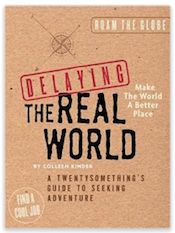
11. Vagabonding: An Uncommon Guide to the Art of Long-Term World Travel. A better guide for longer-term travel (6 weeks or longer), this is a great resource for planning a longer break from your regular life to travel the world. From $11.07 (paperback).
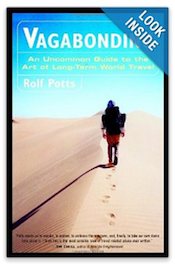
12. Moleskine City Notebooks. The first city guide you write yourself, these notebooks are a cross between a guidebook and a travel journal. Each highly personalizable notebook features a city map (including zoomed-in versions and a metro map), 12 zone maps with street indexes, several blank pages within a 96-page tabbed archive ready for you to record all of your impressions, favorite places, and memories, and much more. From $16.16. (Moleskine also makes more generic Travel Journals.)

13. Journeys Of A Lifetime: 500 of the World’s Greatest Trips [National Geographic]. A highly visual guide, this beautiful hardcover book specializes in the sort of adventure travel you’d expect to see from National Geographic. Not the best resource for exploring city life in other countries, but a great inspiration for everything else (and looks nice on your coffee table, too). Available on Amazon for $28.72 (hardcover).
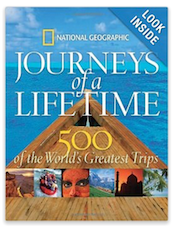
14. Kindle. I have to say, I wasn’t sold on Kindles at first. I really like the tactile experience of holding a book while reading it. However, for travel, this thing really is necessary. Travel involves two things: limited space/weight capacity in your luggage, and lots of waiting time. Even if you’re not packing as light as I do, you still probably don’t want to waste precious luggage space on a big thick book (or two or three!), especially if some of them are guidebooks – but you still want to be able to read your favorite books to pass the time in airports, trains, etc. The Kindle Paperwhite is your best option if you think you’ll be reading in dark circumstances or in bright light (beaches come to mind). $119 for a Kindle Paperwhite, or standard Kindles run from $69.

15. The Best American Travel Writing 2013. Guest-edited by Elizabeth Gilbert (New York Times bestselling author of Eat Pray Love fame), this collection of the year’s best travel writing will definitely be making it onto my wish list this year. $11.55, (paperback).

16. Dream Essentials Sleep Mask & Ear Plugs. Equally necessary for both countries with pre-sunrise Islamic calls to prayer broadcast over loudspeakers from the nearest mosque AND loud European city streets below windows that must stay open due to a lack of air conditioning. Put on this stylish (ha) mask, pop in the accompanying ear plugs, and you’re dead to the world. Also great for airplanes. $9.95 on Amazon.

17. Point It: Traveler’s Language Kit - The Original Picture Dictionary. This dictionary features no words, just pictures of most things you’d need to refer to when abroad. Next time you’re in a country without any knowledge of the language (not recommended, but sometimes unavoidable, particularly for more obscure locales), simply flip open the book, point at the item in question, and let your awkward hand gesturing take care of the rest. Available used on Amazon from $5.98 or for $9.95 new at the MOMA store.
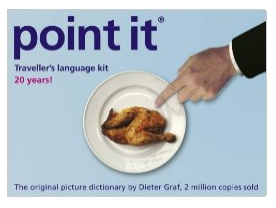
18.REI Clothesline.If you’re packing more than a week’s worth of clothing at a time, you’re going to need to worry about laundry at some point. When you’re traveling on a budget and you’re in a foreign country, sometimes the easiest, least-hassle option is just to hand-wash in the sink of your hotel room (and if you’re doing any kind of camping, it’s your only option!). This clothesline will allow you to hang up your undies to dry no matter where you are. $7 at REI.
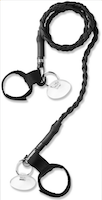
19. Better Than Fiction: True Travel Tales from Great Fiction Writers. If this Lonely Planet compilation of short memoirs by some of the world’s best novelists doesn’t inspire you to start your own adventure, I’m not sure anything will. $12.26 (paperback).
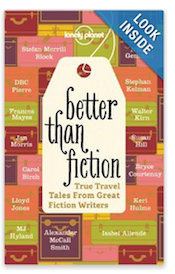
So there you have it - my list of top gift ideas for travel addicts and aspiring travelers alike. Did I miss something? Let me know!
–
Let me come to you! Subscribe by email to get more articles like these delivered straight to your inbox: http://travelpaintrepeat.com/subscribe





